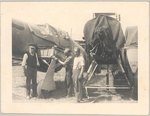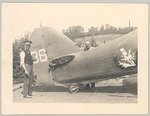de Salier
Airman
Hi All,
Few years back I found some pictures of Belgian Hurricanes, but I have some difficulty with identifying them.
I thought maybe one of you could help.
On both pictures I see the same man, so I presume they where taken at the same time and in the same place.
On the first a partial Hurricane, presumably of No.87 Squadron as I see a K and an H in it's Unit code and I think the first letter in an L. This is supported by the fact that No.87 Squadron was par of the BEF at the beginning of the war.
The second one is more of a mystery for me. It't clearly a Belgian Hurricane, but which one?
Few years back "FlyPast Magazine" published an article about he Belgian Hurricanes.
The article also contained a list of the Belgian Registration/serial numbers these aircraft used, mut No. 36 wasn't among them.
I found a whole bunch of information on the other Hurricanes of the Belgian Air Force, but not of No.36
Can anyone tell me more about these photographs?
(Never seen them in book)
Cheers,
Erwin
Few years back I found some pictures of Belgian Hurricanes, but I have some difficulty with identifying them.
I thought maybe one of you could help.
On both pictures I see the same man, so I presume they where taken at the same time and in the same place.
On the first a partial Hurricane, presumably of No.87 Squadron as I see a K and an H in it's Unit code and I think the first letter in an L. This is supported by the fact that No.87 Squadron was par of the BEF at the beginning of the war.
The second one is more of a mystery for me. It't clearly a Belgian Hurricane, but which one?
Few years back "FlyPast Magazine" published an article about he Belgian Hurricanes.
The article also contained a list of the Belgian Registration/serial numbers these aircraft used, mut No. 36 wasn't among them.
I found a whole bunch of information on the other Hurricanes of the Belgian Air Force, but not of No.36
Can anyone tell me more about these photographs?
(Never seen them in book)
Cheers,
Erwin


